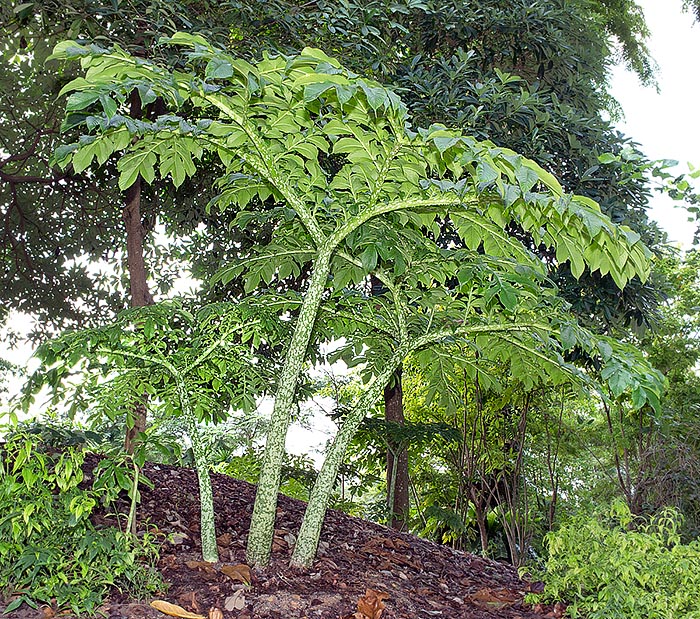Family : Araceae

Text © Pietro Puccio

English translation by Mario Beltramini

Mainly known for the flower, Amorphophallus paeoniifolius is an herbaceous species with petioles sprouting from the soil, even 2 m long and 15-20 cm broad. The huge tubers and the leaves that recall those of the peony, have medicinal virtues © Giuseppe Mazza
The species is native to Andaman Islands, Arunachal Pradesh, Assam, Australia (Northern Territory), Bangladesh, Bhutan, Borneo, Cambodia, China (Anhui, Chongqing, Fujian, Guangdong, Guangxi, Guizhou, Hainan, Henan, Hong Kong, Hubei, Hunan, Jiangsu, Jiangxi, Kin-Men, Macao, Ma-tsu-Pai-chúan, Shanghai, Sichuan, Yunnan and Zhejiang), Darjiling, Fiji, India, Java, Laos, Lesser Sunda Islands, Maluku Islands, Myanmar, Peninsular Malaysia, New Guinea, Philippines, Samoa, Sikkim, Singapore, Society Islands, Sulawesi, Sumatra, Taiwan, Thailand and Vietnam where it lives usually in the forests from the sea level up to about 800 m of altitude.
The generic name is the combination of the Greek terms “ἄμορϕος” (amorfos) = shapeless and “ϕαλλός” (fallos) = phallus, with reference to the shape of the spadix; the specific name is the combination of the name of the genus Paeonia and of the Latin substantive “folium” = leaf, with obvious reference.
Common names: elephant foot yam, telinga potato (English); you bing mo yu (Chinese); apon, bagang, oroi, pungapong (Tagalog); jamikand, suran (Hindi); eles, kembang, suweg, walur (Indonesian); duk dua, kabuk (Lao); suranah (Sanskrit); buk, mansuran (Thai); kurruna kalungu (Tamil); khoai nuwa, nuwa chuoong (Vietnamese).
The Amorphophallus paeoniifolius (Dennst.) Nicolson (1977) is a perennial herbaceous species, deciduous, with globose tuber with a central depression, of 25-30 cm of diameter and about 20 cm tall, of dark brown colour. By the vegetative restart, before the leaves, the tuber produces an inflorescence, on short peduncle, formed by a 10-70 cm long sessile spadix, with the female flowers arranged in the lower part, cylindrical, 3-25 cm long, followed by the male part, cylindrical to obconical, 3-15 cm long and up 10 cm of diameter, surmounted by a sterile appendage of very variable shape, ovoid, globose, globose-depressed or almost conical, of 5-30 cm of length and diameter, usually of glossy dark brown colour.
The inflorescence is surrounded by a campanulate fleshy spathe, 15-60 cm broad and 10-45 cm tall, of green colour with white spots below, greenish purple above with wavy margin.
The inflorescence emits a penetrating odor of rotten meat that serves to attract the pollinating insects; after the pollination the spadix elongates up to 1 m and more with the cylindrical zone in fruit up to 50 cm long and of 8 cm of diameter.
After the blooming, one leaf is emitted, rarely two, on a 0,6-2 m long petiole and 15-20 cm of diameter, of dark green colour with pale green spots, with lamina, 0,7-1,5 m broad, triparted with pennate segments provided of several leaflets of variable shape, ovate, elliptic or lanceolate, with pointed apex, 3-25 cm long and 2-12 cm broad, of pale green colour. The fruits are ovoid berries, 1,5-2 cm long and 1 cm of diameter, red when ripe, containing 2-3 seeds.
It reproduces by seed, that has not a long-lasting germinability, in draining loam rich of humus maintained humid at the temperature of 24-26 °C, with germination times rather variable, starting from 3-4 weeks, and through the small tubers produced during the vegetative season that bloom after 3-4 years. Species suitable to the tropical and subtropical climates, amply cultivated, for the human nutrition as well as for the animals, thanks to the tubers rich of starch, minerals and vitamins, in particular the not sour and pungent varieties, devoid of the needles of calcium oxalate, present in the spontaneous plants, that may cause burnings and irritations of the mouth when ingested raw, and dermatitis and allergic reactions during the handling.
It requires slightly shaded to shaded position and soils rich of organic substance, well drained, sandy, maintained constantly humid during thre vegetative period, but without stagnations, cause of rottenness, dry during the dormancy.
The tubers are ready for the harvesting, or for possible transplants, after the fall of the leaves.
Where the climate does not allow the permanence of the tubers in full ground, for the risk of frosts, they may be extracted by the end of the vegetative season and conserved in dry location up to the following spring, or cultivated in capacious pots, to be sheltered in ambients with temperatures preferably not under the 15 °C.
The tubers and the leaves are utilized in the traditional medicine, in particular the Indian one, for various pathologies.
Synonyms : Dracontium polyphyllum G.Forst. (1786); Dracontium paeoniifolium Dennst. (1818); Dracontium polyphyllum Dennst. (1818); Arum campanulatum Roxb. (1820); Arum rumphii Gaudich. (1826); Pythion campanulatum Mart. (1831); Candarum hookeri Schott (1832); Candarum roxburghii Schott (1832); Candarum rumphii Schott (1832); Amorphophallus campanulatus Decne. (1834); Amorphophallus dubius Blume (1837); Amorphophallus giganteus Blume (1837); Amorphophallus sativus Blume (1837); Arum decurrens Blanco (1837); Kunda verrucosa Raf. (1837); Amorphophallus decurrens (Blanco) Kunth (1841); Arum phalliferum Oken (1841); Arum rumphii Oken (1841); Conophallus giganteus Schott ex Miq. (1856); Conophallus sativus (Blume) Schott (1860); Plesmonium nobile Schott (1864); Amorphophallus chatty Andrews (1872); Amorphophallus rex Prain (1893); Amorphophallus rex Prain ex Hook. f. (1896); Amorphophallus malaccensis Ridl. (1903); Amorphophallus gigantiflorus Hayata (1916); Amorphophallus microappendiculatus Engl. (1923); Amorphophallus dixenii K.Larsen & S.S.Larsen (1974); Hydrosme gigantiflora (Hayata) S.S.Ying (1991).
